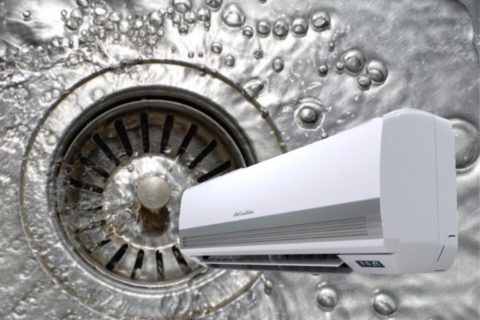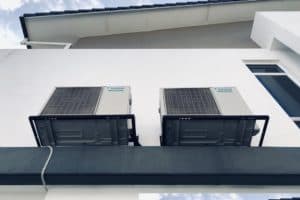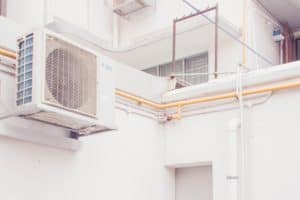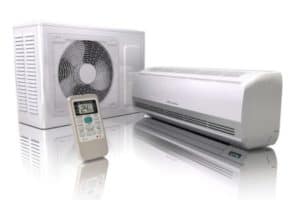What Size Mini Split Do You Need for Grow Room?
Grow rooms must be maintained at a certain range of temperature and humidity levels for the plants to grow properly. If you’re planning to build a grow room, it might be a good idea to use mini splits for cooling and humidity control.
I was visiting a plant farm and noticed that certain types of plants need to be grown inside a temperature and humidity-controlled room known as a grow room or a greenhouse. So, I took a closer look at the cooling system.
It turns out that the farm uses mini splits to cool and dehumidify their grow rooms. The room temperature is maintained at about 79-82°F (26-28°C) with the humidity level at about 70-75%.
I did some studies and calculations. I think a design guide on how to cool a grow room with mini splits would be helpful for those who are seeking a way to cool their grow room.
Sizing Mini Split for Grow Room
The temperature and humidity level requirements for grow rooms vary based on the type of plants you’re trying to grow. Some of the plants even have different requirements based on what stage they’re at (e.g.: seeding, flowering, etc.).
Nevertheless, the general requirement is room temperature at 75-85°F (24-29°C), and relative humidity at 70-80%.
I went inside a few grow rooms at the farm to experience. The installed mini splits seem to keep up with the temperature and humidity requirement pretty well. So, here is how the mini split is designed.
Grow Room Size vs Mini Split Capacity
Sizing the mini split capacity for a grow room is different from a house. Grow rooms are much hotter. So, the conventional way of sizing a mini split won’t work here.
At the farm, one of the grow rooms measures 30 ft in length by 12 ft in width. The resulting floor area is 360 sqft. The height of the grow room measured from the floor to the “ceiling” is 6.5 ft.

Inside these grow rooms, there are 4 units of 12,000 BTU mini splits with two mini splits mounted at each end. The mini splits are set to 20°C (68°F) at maximum fan speed. So, they are basically running at full load.
At each end, one mini split is set to run for 12 hours before the other mini split takes over. So, the grow room is 24H air-conditioned. For non-stop cooling, this is a good way to reduce the workload on each mini split.

In total, the 360 sqft grow room uses 24000 BTU to maintain 79-82°F (26-28°C) at 70-75% relative humidity. By dividing the mini split capacity by the floor area of the grow room, we get a rule-of-thumb size of 66.67 BTU per sqft.
In comparison, when sizing the mini split for houses in the United States, 66.67 BTU per sqft is more than double as we normally use 20-30 BTU per sqft only.
Furthermore, 20-30 BTU per sqft is meant to keep a well-insulated house at 75°F (24°C). For the grow room, 66.67 BTU per sqft is keeping the temperature at merely 79-82°F (26-28°C).
Grow Room Location and Climate
The grow room is located in Malaysia where the mean annual temperature is 25.4°C (77.7°F). At the time of my visit, the outdoor temperature based on weather data is 33.0°C (91.4°F).
So, when I was in the grow room, the mini split was running at what we called the peak load. This means the size of the mini split can keep up during the hottest days which is great.
Sizing the mini split using 66.67 BTU per sqft is suitable for hot and humid climates like Malaysia and Singapore. For other regions, you may need to tune up or down depending on your location.
For example, if you’re living in Texas, United States, the peak outdoor temperature in summer can go up to 100°F (38°C). As a result, you might have to use something like 70-75 BTU per sqft or two units of 15000 BTU mini split for a 360 sqft grow room, or simply up one size.
By the way, if you want to learn more about mini split especially how to design it for your house, consider my Mini Split (eBook). You’ll learn what is Mini Split, how to choose and more importantly, spark more design ideas to improve the energy efficient of your house. But, if you need a second opinion or want someone to help you design, then you can consider my consultation service.
Consultation Service
Ask me for HVAC advice such as brand selection, best model, benefits, features, placement, duct size, grille size, how to design, design check, verification and other HVAC related queries.
Grow Room Insulation
All of the grow rooms I visited on the farm are insulated by a layer of 3-inch air gap. On average, the thermal resistance of a 3-inch air gap is about 3 m²K/W, assuming that the air inside the gap is completely still.
In comparison, a typical 3-inch thick fiberglass insulation with 2 lb/ft³ density has a thermal resistance of about 2.2 m²K/W. That’s slightly less than the thermal insulation capability of still air.
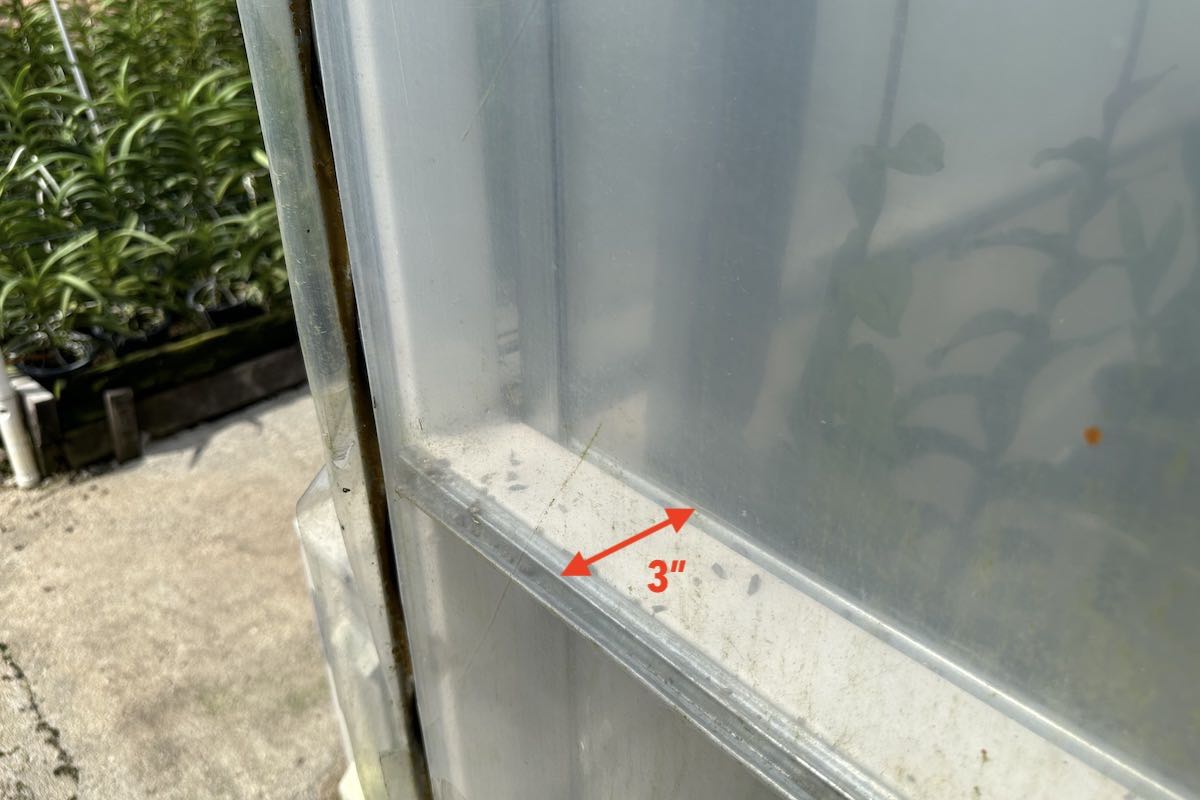
So, in other words, the grow rooms with a layer of 3-inch air gap could be equally good or much better insulated than your grow room, especially if you only use 2-inch thick insulation. That’s something to consider when sizing the mini split.
Type of Mini Split and Air Distribution
The grow room uses the wall-mounted type indoor unit. It is a single-zone system. The unit is controlled by a wireless remote controller which is also equipped with the function to schedule the mini split operation for the 12H auto-changeover.
Most grow rooms are long and rectangular. Wall-mounted units can’t reach too far, especially when mounted at only 5.5 ft from the ground. At max, they probably reach about 7-10 ft only.
To improve that, you can use a fan to enhance the air circulation.
The grow rooms that I visited have a wall-mounted oscillating fan at every 5 ft interval. As a result, I noticed that the cold air is well distributed across the room.

If your grow room has enough height, you may consider a ceiling cassette unit as it is better at air distribution and thus, additional fans may not be required.
Mini Split Installation
The two mini splits are mounted on a custom-made bracket using the wall bracket that comes with the mini split. The piping installation is not the best looking but it is decent for the system to work.

As for the outdoor unit, it is located just beside the indoor unit. Most of the outdoor units have enough space for the hot air discharge but some are not. Nonetheless, they all work just fine.
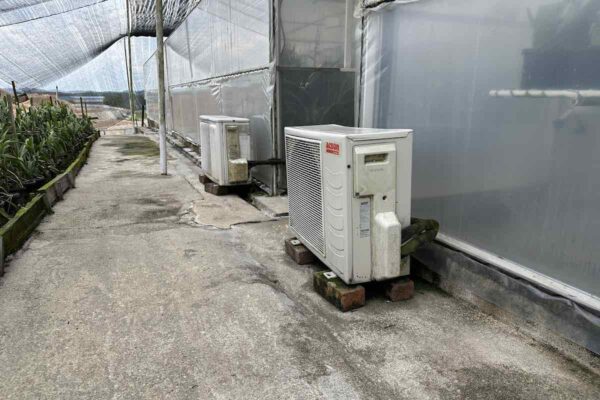
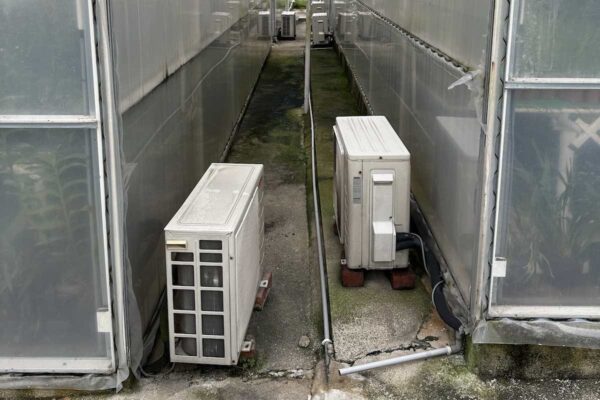
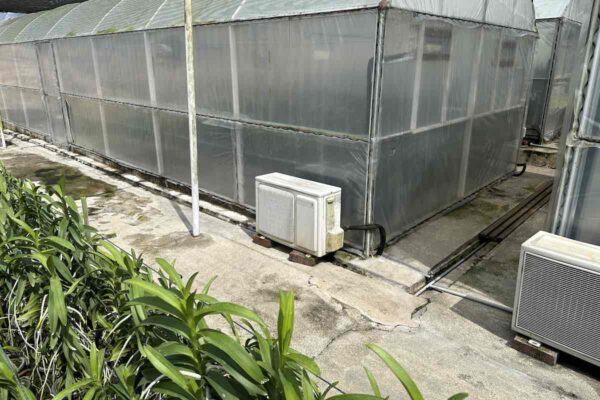
One last observation, the outdoor units are sitting on plain bricks. If your place does snow, follow the manufacturer’s installation manual to properly elevate the outdoor unit.
Are Mini Splits Good for Grow Room?
The cooling options for grow rooms are not many, mainly mini split, portable AC and perhaps, window air conditioner. In some cases, you may choose to extend your central air system as well.
All and all, I think mini split is better than portable AC for grow room cooling because mini splits are much more energy efficient than portable ACs. The difference is even more significant if your grow room requires 24H cooling.
Installing a mini split is not as complicated as extending your existing HVAC system. You can install it by yourself or save yourself the hassle by hiring a professional.
So, What’s the Best Mini Split for Grow Room?
If you’re convinced or decided that mini split is the way to go, here are my recommendations:
- Mitsubishi 16 SEER Mini Split – Reliable brand, large install base, wide choice of installers, good spare parts availability, quality product.
- Daikin 19 SEER Mini Split – Great brand, affordable price, more energy efficient, good temperature control, specialized company.
- Senville LETO Series – Budget option, good energy efficiency, American brand, more functions & features, comes with installation kit.
Final Thought
The HVAC system for grow rooms doesn’t have much guidance like commercial buildings do. So, I took the opportunity to inspect the mini split system during my visit so that I can provide a point of reference for those who are in need.
There are a lot of things to consider when designing a mini split system for your grow room. Nonetheless, its performance and reliability are assured. Otherwise, the farm that I visited won’t be using mini splits. And, judging from the mold on the grow room, I’m pretty sure the mini splits have been running for a very long time.
Lastly, consider my Mini Split (eBook) if you want to know how can you use Mini Split in your house. If you still have doubt or not feeling confident enough, feel free to consult me.
Consultation Service
Ask me for HVAC advice such as brand selection, best model, benefits, features, placement, duct size, grille size, how to design, design check, verification and other HVAC related queries.


